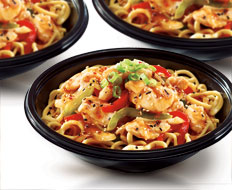Teriyaki Experience, a Canadian-based Asian quick-serve chain with more than 100 units in Canada and locations in Europe, South and Central America, the Caribbean, and the Middle East, is gaining ground in the U.S., with eight open locations and 15 more set to open this year. Another 15 are planned for Canada and an additional 10 internationally. The growing popularity of the noodle is one factor fueling the growth.
“Two or three years ago, 90–95 percent of our customers chose rice with their meal,” says Teriyaki Experience president and COO Nick Veloce. “Now 25–30 percent are choosing noodles, and that number is growing.”
Teriyaki Experience serves both yakisoba noodles, which is a wider, thicker Japanese noodle, and the thinner Pan-Asian udon noodles. The backbone of the Teriyaki Experience menu is a stir-fry vegetable mix with a choice of chicken, beef, shrimp, or tofu served on steamed white or brown rice, yakisoba noodles, or udon noodles. Sauce options for topping the stir-fry include the customer favorite, traditional teriyaki sauce, as well as sweet chili, zesty pineapple, Pan-Asian, and reduced-sodium teriyaki. Noodle soup bowls are also available, as well as wraps, dumplings, and teriyaki salmon.
In the 1980s, Veloce was working for Mrs. Vanelli’s Fresh Italian Food when the chain’s founder, Lou Donato, wanted to offer something more exotic. The only Asian food found in North American quick-service restaurants then was Chinese, Veloce says, and food-court concepts were serving up only burgers, fries, and pizza. Donato believed food-court patrons were ready for something new, and he looked east for inspiration. In April 1986, the first Teriyaki Experience opened in Promenade Mall in Toronto.
“We felt the market was heading in a direction where the Asian category would explode,” says Veloce, who was on the team that launched Teriyaki Experience. “We also thought the quick-serve industry was going to become healthier over time as customers began looking for alternatives to traditional fast food.”
He says with nothing to compare themselves with, the Teriyaki Experience team forged ahead and built a concept around two culinary trends: Asian and healthy.
“Teriyaki Experience attracts two types of customers: those whose main focus is healthy eating and those whose main focus is flavor with a secondary interest in healthy eating,” Veloce says.
In the beginning, Teriyaki Experience chefs cooked with oil. Later, they switched to cooking exclusively with water—but a second option was recently added.
“We will cook in the traditional teppanyaki style with Asian cooking sauce or, if the customer wants an even more healthy choice, we will cook with water,” Veloce says. “The procedure is identical; we just cook with or without sauce.”
Teriyaki Experience
President: Nick Veloce
Year started: 1986
U.S. HQ: Scottsdale, Arizona
Annual Sales: Undisclosed
Total units: 135
Franchise units: 135
www.teriyakiexperience.us
Everything is cooked to order in front of customers, theater-style, allowing them to customize their meals.
“The teppanyaki griddle is a flat griddle with a mirror-clean finish that gets to 550°F and cooks everything extremely quickly,” Veloce says. “We can cook food like chicken, beef, or shrimp from a raw state and still deliver a meal in 2.5 minutes.”
He says drive thrus are possible with that kind of speed of service, but they would take away from the theater experience.
“You’ve got to see the show to understand what we’re offering,” Veloce says. “The visual is so much a part of it.”
Teriyaki Experience can be found in street-front sites, shopping malls, strip plazas, university campuses, theme parks, airports, hospitals, and even supermarket kiosks, which Veloce says is a growing market for the concept.
“We make the most of our space wherever we are,” he says. “Some locations have only eight feet of frontage like in the cafeteria of a university. There we’ll have somewhat limited offerings, but we’re still able to offer 60–70 percent of our entire menu.”
An average ticket at a Teriyaki Experience is about $7, which usually includes a beverage.
“The largest component of beverage sales for us is bottled water, green tea—both hot and cold—and other diet drinks, because we attract health-minded customers,” Veloce says.
The menu at Teriyaki Experience remains stable, but new items are occasionally tested through limited-time offers, and some become permanent offerings. One recent LTO, Hot & Spicy Chicken, consists of chicken, red and green peppers, and onions with a hot and spicy sauce served with yakisoba noodles or steamed rice for $6.99.
“We’ve seen that offering bigger, bolder flavors attracts new customers to our restaurants,” Veloce says.
Teriyaki Experience also attracts new customers through direct-mail promotions and grassroots street marketing, which Veloce calls “old-school social networking.”
“We’ll send out a team of people to walk around and talk about our concept and hand out coupons, either in a shopping mall or around a strip plaza where we’re located,” he says. “For some locations, we’ll drive within a two- or three-mile radius and find places to stop and talk to people.”
New media are not being neglected, however.
“We are revamping our website and getting more into social media,” Veloce says. “But this grassroots marketing, where we actually talk face-to-face with people, has been very effective for us.”







